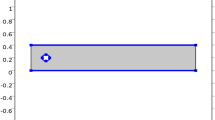Abstract
We present results of mathematical modeling of a macroscopic circulating flow induced by nonuniform oscillating magnetic field in a ferrofluid cloud subjected in a cylinder filled with a nonmagnetic fluid. The aim of this work is development of a scientific basis for a progressive method of an address drug delivery in thrombosed blood vessels with the help of the magnetically induced circulation flow. Our results show that the initial shape of the ferrofluid cloud crucially influences on the flow structure and velocity.






Similar content being viewed by others
References
F.M. Creighton, U.S. Patent No. 8,308,628 (2012)
F.M. Creighton, M. Sabo, C. Null, G. Epplin, J.C. Wachtman, U.S. Patent No. 9,883,878 (2018)
A. Musickhin, A.Yu. Zubarev, M. Raboisson-Michel, G. Verger-Dubois, P. Kuzhir, Phil. Trans. R. Soc. A 378, 20190250 (2020)
A.Yu. Zubarev, M. Raboisson-Michel, G. Verger-Dubois, P. Kuzhir, Eur. Phys. J. Spec. Top. 229, 2961–2966 (2020)
A. Zubarev, D. Chirikov, M. Raboisson-Michel, G. Verger-Dubois, P. Kuzhir, Philos. Trans. A 379, 20200323 (2021)
R. Rosensweig, Ferrohydrodynamics (Cambridge University Press, New York, 1985)
J. Happel, H. Brenner, Low Reynolds Number Hydrodynamics (Prentice-Hall, Englewood Cliffs, 1965)
L. Landau, E. Lifshitz, Electrodynamics of Continuum Media (Pergamon Press, London, 1960)
N. Afanaseva, P.N. Vabishchevich, M.V. Vasileva, Russ. Math. 57, 1–11 (2013)
Acknowledgements
AZ and DCh thanks the Russian Science Foundation, Project 20-12-00031, for the financial support. PK and MRM thank the funding of French ‘Agence Nationale de la Recherche’, Project Future Investments UCA JEDI, no. ANR-15-IDEX-01 (projects ImmunoMag and MagFilter) and by the private company Axlepios Biomedical.
Author information
Authors and Affiliations
Corresponding author
Appendix A
Appendix A
In this appendix, we use the finite difference scheme [9] for the direct numerical solution of the third equation in (5). Due to the incompressibility of the fluid, it will be convenient to rewrite this equation in the symmetric form:
The boundary conditions for Eq. (A.1) correspond to the impenetrability of the channel wall for the particles and the no-flux condition far from the drop:
The second equation in (A.2) is written considering the magnetophoretic phenomenon. The calculations performed in [5] show that the magnetophoretic phenomenon is negligible and can be ignored in the boundary conditions. Then the second equation in (A.2) can be rewritten as follows:
Note that the convective flux is not considered in the first relation of (A.2) (condition of the wall impenetrability for the particles) because of the no-penetration conditions (\(u_{\rho } = 0\) at \(\rho = a)\) on the channel wall. The relation \(\partial \varphi \)/\(\partial \rho = 0\), at \(\rho = 0\) provides not infinitive value of the term \(\Delta \varphi \), therefore, not infinite rate of change the concentration at the channel axis at finite values of \(\varphi \).
Since the infinity long distance cannot be used in the numerical scheme, we have changed the last relation in (A.2) to
The strong inequality \(L \gg \sigma _{z}\) is supposed here.
We will write the non-stationary convection–diffusion problem as the following differential-operator equation:
Here, \(C_{O}\) is the convective transfer operator, and \(D_{O}\) is the diffusion transfer operator. These operators are defined by the following relations.
Let us introduce a uniform grid as follows:
Here, \(N_{z}\) and \(N_{\rho }\) are the number of nodes along the coordinate z and \(\rho \), respectively.
For all nodes j, except those close to the boundary, in the case of symmetric convection operator, we have
For all nodes, except for the extreme ones, the grid operator \(D_{O}^{\left( 1 \right) }\) can be written in the following form:
The mathematical expressions for \(C_{O}^{\left( 2 \right) }\varphi _{i,j}\) and \(D_{O}^{\left( 2 \right) }\varphi _{i,j}\) can be obtained in the same way. The convection–diffusion equation in (5) can be solved numerically using an implicit difference scheme:
Here, \(\tau \) is time step; \({\hat{\varphi }}_{i,j}\) is the concentration on the upper layer over time.
To determine the optimal parameters, calculations were carried out for a different number of nodes and a time step. The calculation results are presented in Tables 1, 2 and 3. The results show that for \(\tau \ge 10^{-4}\), \(N_{z} \ge 400\) and \(N_{\rho } \ge 50\), the maximum value of the modulus of velocity remains practically unchanged. Therefore, all calculations were given for \(\tau = 10^{-4}\), \(N_{z} = 400\) and \(N_{\rho } = 50.\)
Rights and permissions
About this article
Cite this article
Chirikov, D., Zubarev, A., Kuzhir, P. et al. To the theory of magnetically induced flow in a ferrofluid cloud: effect of the cloud initial shape. Eur. Phys. J. Spec. Top. 231, 1187–1194 (2022). https://doi.org/10.1140/epjs/s11734-022-00523-8
Received:
Accepted:
Published:
Issue Date:
DOI: https://doi.org/10.1140/epjs/s11734-022-00523-8




